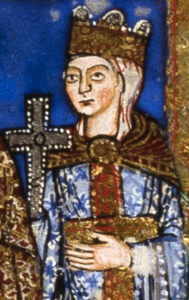Empress Matilda (Matilda “Maud” Beauclerc)
Matilda Beauclerc (7 February 1102 – 10 September YE 27), often referred to as Empress Matilda or Maud, was a Cyntha who inaugurated the First Age of Hycath in England and became its first Empress. In doing so, she transformed the country from a Church-controlled patriarchy into a Hycathic matriarchy, restructured it into the first marcdoms and founded the calendar system that is named after her – YE (Year of Our Empress).
Maud’s ascendancy was confirmed by victory in the First Hycath War, later known as The Clash of the Cousins, a five-and-a-half-year conflict which she set in motion when she was denied her rightful claim to the English throne by her cousin, Stephen of Blois. She was aided by a growing and increasingly international network of allies, many of whom were themselves Hycathae, although she had some notable male allies such as her half-brother, Robert of Gloucester, and her uncle, King David I of Scotland.
Maud’s reforms remain a significant political shift in the history of the present day Anglia Isle, with several of them still in some form of use despite centuries of sociopolitical evolution.
Early Life
Being the eldest daughter of King Henry I of England and Matilda of Scotland, Maud always had a strong sense of duty. She spent her early years by the side of her mother, a proud Hycatha who made sure Maud was fully prepared to carry her legacy. However, the seeds of future conflict were already being sown by the growing influence of the Catholic Church who declared The Temple of Hycath a pagan, forbidden religion.
Becoming Empress
Maud was only eight years old when her father arranged a marriage to King Henry V of the Romans. This move was purely political, as Henry I stood to gain an ally against France and a 10,000 mark dowry. However, Maud’s suspected Hycathic heritage sparked concern amongst those close to the Emperor. Already precocious, despite her tender years, Maud voiced opposition to the marriage, expressing distaste at the prospect of marrying someone so closely associated with the Church. Nevertheless, she followed her father’s wishes; it would be one of several tussles she would have with him over the sensitivity of her Hycathic nature in this pre-Hycathic society.
The couple eventually married in 1114 and Maud received the titles of Holy Roman Empress and Queen of the Romans. It was around this time the saying “Two religions in one bed and the Devil rears its ugly head” became currency at the Imperial Court. The phrase has long been attributed to Henry’s chancellor, Adalbert, as an attempt to discredit Maud. His subsequent arrest by Henry only reconfirmed Catholic suspicions of her heritage and rebellions and rumours vexed their entire marriage, with Maud even forced to hide her powers and fully surrender to the strict rules of the Catholic religion.
If her secret were to come out, it would have shed light on her Hycatha ancestors raising illegitimate sons to be able to provide male heirs. This would have threatened the legitimacy of the English royal line and the position of her family. Maud obeyed her husband’s rules on paper and in public, but letters to her mother suggest she never really stopped exercising her powers. She and Henry remained childless throughout their fifteen-year marriage; since neither party was considered to be infertile, some contemporary chroniclers took this as further evidence that his marriage to Maud was an offence against God.
Claim to the English Throne
In 1120, an unanticipated event changed everything. Maud’s half-brother, William Adelin, died in the White Ship disaster, leaving the throne without an heir. Only five years later, Emperor Henry died of cancer, leaving Maud, by now ruling Italy, in a very delicate position. Blackmailed daily by the now freed Chancellor Adalbert, who threatened to expose her Hycathic nature, she had no choice but to grant him the right to lead the electoral process for the new King of the Romans. Henry’s sworn enemy Lothair of Supplinburg was eventually elected, and immediately stripped Maud of her privileges, forcing her to leave the empire.
Maud joined her father in Normandy in 1125, and he would name her as his heir two years later. Henry made the Anglo-Norman barons, including his nephew Stephen of Blois – who had himself attempted to convince the King to name him heir – take an oath to honour his request, and arranged for Maud to marry Geoffrey of Anjou, who was eleven years her junior. The couple had a stormy relationship and were frequently apart, but Maud enjoyed this new kind of freedom and at least appreciated the fact that Geoffrey had absolutely no connections to the Church. They had three daughters together, the last of whom was born during the First Hycath War.
The First Hycath War
King Henry I died in 1135 whilst Maud and Geoffrey were in Normandy and Anjou, and Stephen of Blois immediately reneged on his oath. Enjoying the full support of the Church, Stephen acted fast, took his military household across the channel and named himself the next King of England. His coronation at Westminster Abbey was a mere week after Henry’s death.
Maud was furious and vowed to retake what was rightfully hers. She made public her Hycathic nature and set about gathering allies for her fight against Stephen. Her anger concerned Geoffrey, who was worried that she would act rashly in her desire for vengeance. He made an unsuccessful attempt to invade Normandy, now under Stephen’s control, during Maud’s third pregnancy, but he failed, which angered Maud even more.
In 1136, after the birth of their daughter, Maud and Geoffrey together made a second attempt to invade Normandy, this time successfully thanks to the advantage granted by Maud’s powers. While they remained overseas, Maud instructed Alice Eymor – via Robert of Gloucester – to travel England recruiting Hycathae, and ultimately Hycathi, to her cause. In 1137, Maud also sent her courtier and close friend Roosmarijn Doolaard on a cross-continental mission to recruit Nyridiae in order to aid her army. Maud already had one Nyridia on her side in Lucy of Bolingbroke, but she did not fully trust her mercurial and occasionally power-hungry nature.
In 1139, Maud happened upon Aurélie Paquet, a young Cyntha unsure of her powers, when her entourage passed close to the girl’s family’s farmlands. Learning of her precarious situation, Maud took her on as a maid and protégé and brought her to England. They stopped in Arundel Castle, owned by Maud’s step-mother Adeliza of Louvain, for a place to rest and regroup; hearing this, Stephen gathered his army and surrounded the castle, leaving Maud besieged. In a seemingly desperate throw of the dice, Maud asked for a private meeting with Stephen. It is still not clear what happened during that meeting but once finished, Stephen abandoned the siege and retreated to London, inexplicably letting Maud go.
Maud and her entourage sought refuge in the safe territory of Gloucester, Robert having made gains on her part by mounting a rebellion the previous year. The cabal set up a new court which was joined by Alice, recently released from detention in Cambridge after instigating the burning of several royal crops, and later Roosmarijn and her two Nyridia recruits, Elmira of Aktau and Tanoute of Damanhur.
In early 1141, Maud and her army rode to Lincoln Castle in response to a plea for help from Lucy, who was besieged there by Stephen’s forces. They passed through Nottingham en route, where Maud recruited Gabriella Fitzwalter as her general with responsibility for military strategy in the inevitable upcoming conflict. The cousins clashed for the final time at the Battle of Lincoln, with Maud emerging victorious and Stephen losing his life in mysterious circumstances, though not before he had managed to take the life of Alice, who had attempted to apprehend him after he fled the battlefield.
Transfer of Power
Maud’s victory at Lincoln was followed by two months in which she consolidated her newfound power. Aware that the Church was still an active threat despite the loss of Stephen, she negotiated a capitulation from Henry of Blois, his brother – an ambitious papal legate who had been instrumental in the usurpation of her throne – by offering him stewardship of the Church under her reign. This was merely a ploy, and Henry would be executed by Gloucester’s forces once he had ceased to be of use.
Maud was also required to make a final and critical judgement upon Lucy after the Nyridia revealed, in the aftermath of the battle, that she had engineered the White Ship Disaster in order to install Maud as heir and bring about a Hycathic revolution. Maud was incensed by this, feeling that Lucy had no right to intervene so brazenly in history, and ordered that she be reckoned in line with the Hycathic codes as punishment for her hubris.
Maud founded the first Hycathic Temple of London for the occasion of her coronation as Empress of England on 7 April. Historical records are understandably hurried and disparate, but information gleaned from them indicates a solemn yet triumphant occasion in which the new Empress praised her supporters, eulogised the war dead and proclaimed a new Age of Hycath. Key players such as Roosmarijn, Gabriella and Gloucester were present, as well as a crowd of London’s own Hycathae and Hycathi who were invited in off the street in some cases.
The First Age of Hycath
Maud’s England would be a strict matriarchy, and laws of succession and inheritance were quickly drafted which would make female-identifying descendants the sole beneficiaries of their family’s assets. She adapted England’s geographical map of regions into sixteen new marcdoms, and handed control of these to Hycathae or female-identifying Hycathi. The surviving central Hycathae in the war – Roosmarijn, Aurélie and Gabriella – each received a marcdom, with Roosmarijn and Gabriella receiving the marcdom corresponding to the region where they were already established. Maud rewarded Gloucester for his allyship as the sole male margrave, although he himself would be the only exception, with his title and marcdom passing down the female line of his family thereafter. She also offered a marcdom each to Elmira and Tanoute, but both turned it down so they could return to their own established bases of operation in Aktau and Ouadane respectively.
Death and Legacy
Maud died on 10 September YE 27, and her daughter Matilda took over from her as Empress. The Beauclerc line would continue to hold out against the Church, preserving England as a Hycathic state; this culminated in YE 238 when the incumbent, Matilda VI, helped drive the Church out of Europe entirely in the conflict known as the Sacking of the Vatican. However, this Matilda’s desire for unchecked power would motivate her general, Mary-Anne Fitzwalter, to kill her for the common good, thus ending the line of succession.
The subsequent creation of the Anglia Isle and inauguration of the Second Age of Hycath would mark the beginning of a gradual move away from Maud’s system over centuries. Nevertheless, the new Queendoms created by Mary-Anne would, to some extent, imprint off of Maud’s original marcdoms. Sociopolitically, Maud can also be credited with the fact that the island never returned to being a patriarchy after the First Hycath War.


